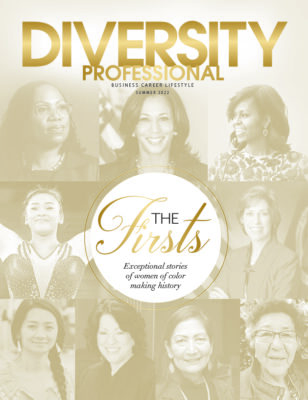INCLUSIVE, EQUITABLE AND ANTI-RACIST LEADERSHIP CRUCIAL IN TODAY’S WORKSPACES
Insightful leadership perspective to initiate a transformational journey.
For most of us today, we have gone from being expected to show up in the workplace to having work show up in our place. Yet, the journey to truly understand one another’s spaces remains long. Historically, showing up in the workspace has meant presenting in the ways of thinking and communicating that have been endorsed and rewarded, whether directly or indirectly, by a dominant culture.
Practicing anti-racism requires that we first understand the historical ideologies and values that influenced these practices and set them as the standards or best practices. As one of America’s foremost historians and leading anti-racist scholars, Dr. Ibram X. Kendi, writes in his New York Times bestselling book, How To Be An Antiracist, “Whoever makes the cultural standard makes the cultural hierarchy. The act of making a cultural standard and hierarchy is what creates cultural racism.” It is not about seeing people around us as racist, but rather to dismantle racism in organizations, we need to learn to see racist practices that implicitly and explicitly benefit some of us, and not others.
Once learned in one context, we can apply the learning to other contexts.
Until recently, the diversity, equity, and inclusion field has been evolving from compliance to competitive advantage. Highlighting diversity of thought or cognitive diversity, some practitioners have avoided the conversations about the origins of these thoughts and the expectations they bring. We see it in the approach to two-dimensional (2D) diversity. However, focusing on acquired diversity (traits you gain from experience) automatically requires us to look at that diversity through the lens of inherent diversity (traits you are born with), and more specifically racial diversity.
How we navigate the world and how the world receives us through the traits with which we are born is inevitably going to influence the acquired diversity that we would be enabled to have. With our personal spaces being exposed to those in our workplace, it is essential that we reexamine what has been taken for granted as the correct way to show up, to mitigate the masking of identities that has been perpetuated.
For today’s organizations, achieving effective leadership, beyond inclusive leadership, will mean practicing antiracist leadership. In one form or another, we have all participated in racism. Why? Because our notions of effective and inclusive leadership have ignored historical elements of oppression, excluded certain cultural dynamics, and prescribed a set of standards ingrained in racial hierarchy and superiority.
For example, words like tribe, civility and professional are ingrained in racism. Most workspaces have also rewarded and preferred competition, transnationality, and individualism, which are deeply rooted in Anglo culture, while minimizing cooperation, relationism, and collectivism. Examples include performance reviews that tend to rely on what is visibly highlighted and vocalized by reviewees themselves; unpublished salary ranges that assume equality in negotiation and a knowledge of how to negotiate aggressively; facts and numbers being prioritized over stories, and often without questioning the source or context in which these numbers were gathered.
These standards have contributed to BIPOC (Black, Indigenous and people of color) being excluded from spaces, opportunities, and equal pay.
As a leader, ask yourself these questions:
1 Whose cultural values does my idea and approach promote?
2 Who might not feel safe espousing this approach?
3 How can I learn more and adjust to incorporate different approaches in the journey?
4 What can I forego in the outcome to further equity and inclusion in the journey?
5 How can I utilize outcomes to invest back into fairness and equity?
If we are to reconsider the remote workspace, for instance, applying anti-racism requires us to see that households of color are more likely than white households to be multigenerational with caregiving responsibilities. It requires us to see that some racial groups, namely Black employees, are likely to fear dire consequences, for voicing dissent, albeit a dissent that one from the dominant culture could voice and be rewarded.
Words like ‘speak up’ culture reinforce a dominant standard in communication, a veiled egalitarianism when subtle exclusions are so prevalent. In a virtual meeting, expecting multiple perspectives to be shared openly ignores power dynamics. Spaces need to be restructured to redistribute power. For example, include open floor discussion with time allotments for verbal sharing and chat box sharing, with private, anonymous chats, as well as breakout rooms with conversation and equal airtime guidelines.
At times, it may mean disabling chat to manage dominant voices or tasking a person to monitor the screen for whose hand is raised and ensure that connectivity is equal for everyone. This person would need to be different in each meeting due to different circles of influence and trust levels among teammates.
One approach to engage members to champion one another is having a buddy for meetings and beyond. In meetings, each person can select another person to be their buddy for that meeting to check in with them, that they are being visible, heard, and validated (in their identities). This might seem awkward at first, yet these practices surface all perspectives, while recognizing power imbalances among various identities and roles. With time, rotating buddies will mean growth partnerships and connections go beyond affinity with any one identity.
Using a platform such as Impactree.com can be another way to equalize influence. The team can take collective, customized actions together, on topics that matter for them. These scalable actions can help bring positive impact while making members feel supported in their ideas and values.
If we are to show up in one another’s spaces, as ourselves, in this remote work environment, we need to proactively redesign spaces together, so that one’s success is not predicated on their identity and one’s identity is not a predictor of their success. Inclusive, equitable and antiracist leaders practice this.









